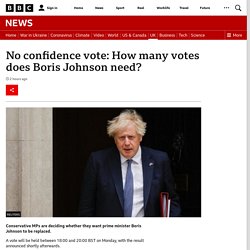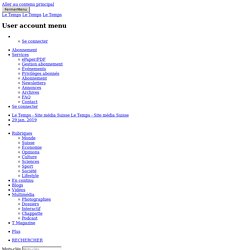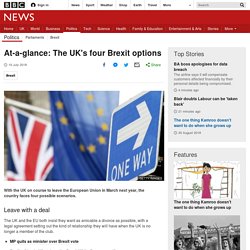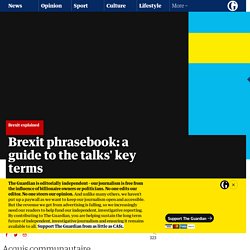

Brexit Whats new V2. WTF is Brexit? - Foil Arms and Hog. Brexit Divorce - Foil, Arms and Hog. Brexit explained: What is the problem with the Irish border? NPR Choice page. No confidence vote in Theresa May: Rules for a challenge. Theresa May is fighting to stay on as prime minister after a no confidence vote among Conservative MPs was triggered.

How does the vote work and what could happen next? As leader of the Conservative Party, Theresa May depends on the continued support of her MPs. That has been formally called into question after some of them wrote letters saying they had no confidence in her. Under the party's rules, at least 15% of Tory MPs must write such a letter to make a leadership challenge possible. That mark - which translates as 48 MPs - has now been passed. The vote, which is a secret ballot, will be held between 18:00 and 20:00 on Wednesday. To win, Mrs May needs to secure 159 votes - half of her MPs, plus one. But if she loses there will be a leadership contest and she will be barred from standing. There is a third option - Mrs May wins, but only by a few votes. It is likely to follow the following format: To enter the race, prospective leaders need to be nominated by two fellow Tory MPs.
Brexit: What happens now? Brexit A brief timeline. Brexit: All you need to know about the UK leaving the EU. Under the terms of the deal, that won't change on 1 January, but to be sure that neither side has an unfair advantage, both sides had to agree to some shared rules and standards on workers' rights, as well as many social and environmental regulations.
You can read more detail on other aspects of the deal, including more on travel, fishing, and financial services, here. Under the terms of the deal, that won't change on 1 January, but to be sure that neither side has an unfair advantage, both sides had to agree to some shared rules and standards on workers' rights, as well as many social and environmental regulations. You can read more detail on other aspects of the deal, including more on travel, fishing, and financial services, here. Brexit: guide de rattrapage à deux mois de l’échéance. Le Brexit semble embourbé dans une crise permanente, monopolisant toute l’énergie du Royaume-Uni depuis le référendum de juin 2016.

Ce mardi soir, les députés britanniques vont une nouvelle fois voter sur des amendements très importants pour la suite du processus. Pour essayer de s’y retrouver dans cet imbroglio, alors qu’il ne reste que deux mois avant l’entrée en vigueur théorique du Brexit, le 29 mars, voici un guide de rattrapage express. Brexit: tout ce qu'il faut savoir sur l'accord de divorce. Les chefs d’Etat et de gouvernement de l’Union européenne se sont retrouvé dimanche matin à Bruxelles pour un bref sommet afin de signer l’acte de divorce avec le Royaume-Uni : 585 pages, trois protocoles (Irlande, Gibraltar et Chypre) et une déclaration politique de 26 pages sur la relation future entre les deux parties.

L’ensemble reste suspendu au vote, loin d’être acquis, des députés britanniques de la Chambre des communes, attendu autour du 11 décembre. Pour en arriver là, il aura fallu vingt mois de négociations depuis l’activation, le 29 mars 2017, par la Première ministre britannique Theresa May, de l’article 50 du traité sur l’Union européenne organisant la procédure de retrait. Neuf mois plus tôt, le 23 juin 2016, les Britanniques avaient voté à 52 % en faveur du Brexit. Pour l’essentiel, les négociations ont été britannico-britanniques, la majorité conservatrice se déchirant sur le type de Brexit qu’elle voulait. Que se passe-t-il le 29 mars 2019 ? At-a-glance: The UK's four Brexit options. Image copyright Getty Images With the UK on course to leave the European Union in March next year, the country faces four possible scenarios.

Leave with a deal The UK and the EU both insist they want as amicable a divorce as possible, with a legal agreement setting out the kind of relationship they will have when the UK is no longer a member of the club. Prime Minister Theresa May wants to keep close ties with the EU in certain areas, such as trade in agricultural products and allowing skilled migrants access to jobs in the UK. She says her plan will allow Britain to take back control of its laws, money and borders, just like people voted for in the 2016 EU referendum, while also allowing as "frictionless" trade as possible and avoiding a physical border for Northern Ireland.
But it has been attacked as an unworkable compromise by people from both the Remain and Leave ends of the debate.
The EU Referendum: 23rd JUNE 2016. Brexit. Brexit phrasebook: a guide to the talks' key terms. Acquis communautaire The entire body of European laws: all the treaties, regulations and directives passed by the EU’s institutions, plus all the rulings of the European court of justice (see below).

Every member state has incorporated the acquis into their legal system. Article 50. Brexit: The people who are negotiating.
What is a 'No deal' Brexit? Brexit explained: What the X@X!# is happening NOW?! Brexit: EU sees 'positive elements' in UK's Chequers plan. Image copyright AFP/Getty The EU has cast doubt on claims its chief negotiator described the government's Brexit plan as "dead in the water".

Labour MP Stephen Kinnock attributed the remarks - which he said were in French - to Michel Barnier after a meeting in Brussels. EU Commission spokesman Margaritis Schinas urged journalists to wait for a transcript to be published. The Chequers plan contains some "positive elements", he added.
UK: BREXIT - Cartoons - Information - Videos. Articles on Brexit. Untitled. Sam Gyimah: second Brexit referendum best option for both sides. Sam Gyimah, the universities minister who resigned in protest at the prime minister’s Brexit plan and pledged to vote against it, has said a second referendum could be the most sensible path for both leave and remain supporters, and dismissed Theresa May’s agreement with Brussels as a “deal in name only”.

The Conservative MP, who on Friday became the seventh minister to quit Theresa May’s government over Brexit, called for a vote to gauge the public’s mood if May loses the meaningful vote in parliament on 11 December. He said the deal May had brokered with the European Union would “cripple our interests for decades to come” and a second referendum could avert “chaos”. “There is a blocking minority in the House of Commons for almost every possible option which means that letting the people decide, now that we know more, might be the most sensible path for both leavers and remainers,” Gyimah told the BBC Radio 4 Today programme on Saturday. “Does the deal deliver 100% of what I wanted? No. What is the 'Backstop' and why is it preventing the signing of the Withdrawal Agreement?